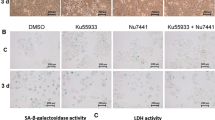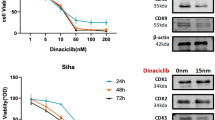Abstract
Cyclin D1 is involved in cell-cycle arrest in DNA-damage response. This study tested the hypothesis that cyclin D1 regulates mitochondrial apoptosis. Cyclin D1 was induced by low-dose ionizing radiation (LDIR; 10-cGy X-ray) in human keratinocytes with an adaptive radioresistance that can be inhibited by short interfering RNA (siRNA)-mediated cyclin D1 inhibition. Cyclin D1 was found to form complex with chaperon 14-3-3ζ in unstressed cells and mutation of 14-3-3ζ Ser-58 to Asp (S58D) significantly impaired 14-3-3ζ binding to cyclin D1. The formation of cyclin D1/14-3-3ζ complex was differently regulated by exposure to low (10-cGy X-ray) versus high (5-Gy γ-ray) doses of radiation. Unlike exposure to 5-Gy that predominantly enhanced cyclin D1 nuclear accumulation, LDIR induced the dissociation of the cyclin D1/14-3-3ζ complex without nuclear translocation, indicating that cytosolic accumulation of cyclin D1 was required for LDIR-induced adaptive response. Further studies revealed a direct interaction of cyclin D1 with proapoptotic Bax and an improved mitochondrial membrane potential (Δψm) in LDIR-treated cells. Consistently, blocking cyclin D1/Bax formation by cyclin D1 siRNA reversed Δψm and inhibited the LDIR-associated antiapoptotic response. These results demonstrate the evidence that cytosolic cyclin D1 is able to regulate apoptosis by interaction with Bax in LDIR-induced adaptive resistance.





Similar content being viewed by others
Abbreviations
- Δψm:
-
mitochondrial membrane potential
- DAPI:
-
4,6-diamidino-2-phenylindole
- EYFP:
-
enhanced yellow fluorescent protein
- HDIR:
-
high-dose ionizing radiation
- IHC:
-
immunohistochemistry
- IR:
-
ionizing radiation
- LDIR:
-
low-dose ionizing radiation
- NP-40:
-
nonidet P-40
- PMSF:
-
phenylmethylsulfonylfluoride
- siRNA:
-
short interfering RNA
References
Ahmed KM, Dong S, Fan M, Li JJ . (2006). Nuclear factor κB P65 inhibits mitogen-activated protein kinase signaling pathway in radioresistant breast cancer cells. Mol Cancer Res 4: 945–955.
Biliran Jr H, Wang Y, Banerjee S, Xu H, Heng H, Thakur A et al. (2005). Overexpression of cyclin D1 promotes tumor cell growth and confers resistance to cisplatin-mediated apoptosis in an elastase-myc transgene-expressing pancreatic tumor cell line. Clin Cancer Res 11: 6075–6086.
Brunet A, Bonni A, Zigmond MJ, Lin MZ, Juo P, Hu LS et al. (1999). Akt promotes cell survival by phosphorylating and inhibiting a Forkhead transcription factor. Cell 96: 857–868.
Chen X, Shen B, Xia L, Khaletzkiy A, Chu D, Wong JY et al. (2002). Activation of nuclear factor kappaB in radioresistance of TP53-inactive human keratinocytes. Cancer Res 62: 1213–1221.
Costantini P, Jacotot E, Decaudin D, Kroemer G . (2000). Mitochondrion as a novel target of anticancer chemotherapy. J Natl Cancer Inst 92: 1042–1053.
Daosukho C, Kiningham K, Kasarskis EJ, Ittarat W, St Clair DK . (2002). Tamoxifen enhancement of TNF-alpha induced MnSOD expression: modulation of NF-kappaB dimerization. Oncogene 21: 3603–3610.
Fan M, Ahmed KM, Coleman MC, Spitz DR, Li JJ . (2007). Nuclear factor-kappaB and manganese superoxide dismutase mediate adaptive radioresistance in low-dose irradiated mouse skin epithelial cells. Cancer Res 67: 3220–3228.
Feinendegen LE, Bond VP, Sondhaus CA, Muehlensiepen H . (1996). Radiation effects induced by low doses in complex tissue and their relation to cellular adaptive responses. Mutat Res 358: 199–205.
Guo G, Yan-Sanders Y, Lyn-Cook BD, Wang T, Tamae D, Ogi J et al. (2003). Manganese superoxide dismutase-mediated gene expression in radiation-induced adaptive responses. Mol Cell Biol 23: 2362–2378.
Hermeking H, Lengauer C, Polyak K, He TC, Zhang L, Thiagalingam S et al. (1997). 14-3-3 Sigma is a p53-regulated inhibitor of G2/M progression. Mol Cell 1: 3–11.
Hu CD, Chinenov Y, Kerppola TK . (2002). Visualization of interactions among bZIP and Rel family proteins in living cells using bimolecular fluorescence complementation. Mol Cell 9: 789–798.
Karbowski M, Norris KL, Cleland MM, Jeong SY, Youle RJ . (2006). Role of Bax and Bak in mitochondrial morphogenesis. Nature 443: 658–662.
Kelsey KT, Memisoglu A, Frenkel D, Liber HL . (1991). Human lymphocytes exposed to low doses of X-rays are less susceptible to radiation-induced mutagenesis. Mutat Res 263: 197–201.
Klokov D, Criswell T, Leskov KS, Araki S, Mayo L, Boothman DA . (2004). IR-inducible clusterin gene expression: a protein with potential roles in ionizing radiation-induced adaptive responses, genomic instability, and bystander effects. Mutat Res 568: 97–110.
Limoli CL, Kaplan MI, Giedzinski E, Morgan WF . (2001). Attenuation of radiation-induced genomic instability by free radical scavengers and cellular proliferation. Free Radic Biol Med 31: 10–19.
Nomura M, Shimizu S, Sugiyama T, Narita M, Ito T, Matsuda H et al. (2003). 14-3-3 Interacts directly with and negatively regulates pro-apoptotic Bax. J Biol Chem 278: 2058–2065.
Oyama T, Kashiwabara K, Yoshimoto K, Arnold A, Koerner F . (1998). Frequent overexpression of the cyclin D1 oncogene in invasive lobular carcinoma of the breast. Cancer Res 58: 2876–2880.
Pandey BN, Gordon DM, De Toledo SM, Pain D, Azzam EI . (2006). Normal human fibroblasts exposed to high- or low-dose ionizing radiation: differential effects on mitochondrial protein import and membrane potential. Antioxid Redox Signal 8: 1253–1261.
Paulovich AG, Toczyski DP, Hartwell LH . (1997). When checkpoints fail. Cell 88: 315–321.
Powell DW, Rane MJ, Joughin BA, Kalmukova R, Hong JH, Tidor B et al. (2003). Proteomic identification of 14-3-3zeta as a mitogen-activated protein kinase-activated protein kinase 2 substrate: role in dimer formation and ligand binding. Mol Cell Biol 23: 5376–5387.
Qi W, Martinez JD . (2003). Reduction of 14-3-3 proteins correlates with increased sensitivity to killing of human lung cancer cells by ionizing radiation. Radiat Res 160: 217–223.
Rothkamm K, Lobrich M . (2003). Evidence for a lack of DNA double-strand break repair in human cells exposed to very low X-ray doses. Proc Natl Acad Sci USA 100: 5057–5062.
Sakamaki T, Casimiro MC, Ju X, Quong AA, Katiyar S, Liu M et al. (2006). Cyclin D1 determines mitochondrial function in vivo. Mol Cell Biol 26: 5449–5469.
Shadley JD, Afzal V, Wolff S . (1987). Characterization of the adaptive response to ionizing radiation induced by low doses of X rays to human lymphocytes. Radiat Res 111: 511–517.
Sherr CJ . (1994). G1 phase progression: cycling on cue. Cell 79: 551–555.
Sumrejkanchanakij P, Tamamori-Adachi M, Matsunaga Y, Eto K, Ikeda MA . (2003). Role of cyclin D1 cytoplasmic sequestration in the survival of postmitotic neurons. Oncogene 22: 8723–8730.
Ulsh BA, Miller SM, Mallory FF, Mitchel RE, Morrison DP, Boreham DR . (2004). Cytogenetic dose–response and adaptive response in cells of ungulate species exposed to ionizing radiation. J Environ Radioact 74: 73–81.
Wang T, Hu YC, Dong S, Fan M, Tamae D, Ozeki M et al. (2005). Co-activation of ERK, NF-kappaB, and GADD45beta in response to ionizing radiation. J Biol Chem 280: 12593–12601.
Xiao B, Smerdon SJ, Jones DH, Dodson GG, Soneji Y, Aitken A et al. (1995). Structure of a 14-3-3 protein and implications for coordination of multiple signalling pathways. Nature 376: 188–191.
Yang J, Liu X, Bhalla K, Kim CN, Ibrado AM, Cai J et al. (1997). Prevention of apoptosis by Bcl-2: release of cytochrome c from mitochondria blocked. Science 275: 1129–1132.
Yoshida K, Yamaguchi T, Natsume T, Kufe D, Miki Y . (2005). JNK phosphorylation of 14-3-3 proteins regulates nuclear targeting of c-Abl in the apoptotic response to DNA damage. Nat Cell Biol 7: 278–285.
Zhang L, Yu J, Park BH, Kinzler KW, Vogelstein B . (2000). Role of BAX in the apoptotic response to anticancer agents. Science 290: 989–992.
Acknowledgements
We thank Dr N Colburn (National Cancer Institute, NIH) for providing human keratinocytes HK18 cells, Dr S Liu (Purdue University School of Health Sciences) for invaluable help with animal experiments. This work was supported by NIH NCI grant RO1 101990 and the Department of Energy grant DE-FG02-03ER63634 to JJL.
Author information
Authors and Affiliations
Corresponding author
Rights and permissions
About this article
Cite this article
Ahmed, K., Fan, M., Nantajit, D. et al. Cyclin D1 in low-dose radiation-induced adaptive resistance. Oncogene 27, 6738–6748 (2008). https://doi.org/10.1038/onc.2008.265
Received:
Revised:
Accepted:
Published:
Issue Date:
DOI: https://doi.org/10.1038/onc.2008.265
- Springer Nature Limited
Keywords
This article is cited by
-
Chrysin Encapsulated Copper Nanoparticles with Low Dose of Gamma Radiation Elicit Tumor Cell Death Through p38 MAPK/NF-κB Pathways
Biological Trace Element Research (2023)
-
Anti-inflammatory and anticancer effects of p-methoxycinnamic acid, an active phenylpropanoid, against 1,2-dimethylhydrazine-induced rat colon carcinogenesis
Molecular and Cellular Biochemistry (2019)
-
G protein-coupled KISS1 receptor is overexpressed in triple negative breast cancer and promotes drug resistance
Scientific Reports (2017)
-
Brain Radiation Information Data Exchange (BRIDE): integration of experimental data from low-dose ionising radiation research for pathway discovery
BMC Bioinformatics (2016)
-
Adaptive stress signaling in targeted cancer therapy resistance
Oncogene (2015)




